Viverridae
Viverridae is a family of small to medium-sized mammals, the viverrids (/vaɪˈvɛrɪdz/), comprising 15 genera, which are subdivided into 38 species.[1] This family was named and first described by John Edward Gray in 1821.[3] Members of this family are commonly called civets or genets. Viverrids are found in South and Southeast Asia, across the Wallace Line, all over Africa, and into southern Europe. Their occurrence in Sulawesi and in some of the adjoining islands shows them to be ancient inhabitants of the Old World tropics.[4]
| Viverridae[1] | |
|---|---|
 | |
| Viverrids, including (top left to bottom right), species of Paradoxurus, Genetta, Paguma and Arctictis | |
| Scientific classification | |
| Kingdom: | Animalia |
| Phylum: | Chordata |
| Class: | Mammalia |
| Order: | Carnivora |
| Suborder: | Feliformia |
| Infraorder: | Viverroidea |
| Family: | Viverridae Gray, 1821 |
| Genera | |
| |
Characteristics

Viverrids have four or five toes on each foot and half-retractile claws. They have six incisors in each jaw and molars with two tubercular grinders behind in the upper jaw, and one in the lower jaw. The tongue is rough with sharp prickles. A pouch or gland occurs beneath the anus, but there is no cecum.[3]
Viverrids are the most primitive of all the families of feliform Carnivora and clearly less specialized than the Felidae. In external characteristics, they are distinguished from the Felidae by the longer muzzle and tuft of facial vibrissae between the lower jaw bones, and by the shorter limbs and the five-toed hind foot with the first digit present. The skull differs by the position of the postpalatine foramina on the maxilla, almost always well in advance of the maxillopalatine suture, and usually about the level of the second premolar; and by the distinct external division of the auditory bulla into its two elements either by a definite groove or, when rarely this is obliterated, by the depression of the tympanic bone in front of the swollen entotympanic. The typical dental formula is: 3.1.4.23.1.4.2, but the number may be reduced, although never to the same extent as in the Felidae.[4]
Their flesh-shearing carnassial teeth are relatively undeveloped.[5] Most viverrid species have a penis bone (a baculum).[6]
Classification
Living species
In 1821, Gray defined this family as consisting of the genera Viverra, Genetta, Herpestes, and Suricata.[3] Reginald Innes Pocock later redefined the family as containing a great number of highly diversified genera, and being susceptible of division into several subfamilies, based mainly on the structure of the feet and of some highly specialized scent glands, derived from the skin, which are present in most of the species and are situated in the region of the external generative organs. He subordinated the subfamilies Hemigalinae, Paradoxurinae, Prionodontinae, and Viverrinae to the Viverridae.[4]
In 1833, Edward Turner Bennett described the Malagasy fossa (Cryptoprocta ferox) and subordinated the Cryptoprocta to the Viverridae.[7] A molecular and morphological analysis based on DNA/DNA hybridization experiments suggests that Cryptoprocta does not belong within Viverridae, but is a member of the Eupleridae.[8]
The African palm civet (Nandinia binotata) resembles the civets of the Viverridae, but is genetically distinct and belongs in its own monotypic family, the Nandiniidae. There is little dispute that the Poiana species are viverrids.[1]
DNA analysis based on 29 species of Carnivora, comprising 13 species of Viverrinae and three species representing Paradoxurus, Paguma and Hemigalinae, confirmed Pocock's assumption that the African linsang Poiana represents the sister-group of the genus Genetta. The placement of Prionodon as the sister-group of the family Felidae is strongly supported, and it was proposed that the Asiatic linsangs be placed in the monogeneric family Prionodontidae.[9]
| Subfamily | Genus | Species | Image of type species |
|---|---|---|---|
| Viverrinae | Viverra Linnaeus, 1758 |
|
 |
| Viverricula Hodgson, 1838 | Small Indian civet (V. indica) Hodgson, 1838 | 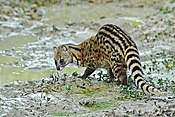 | |
| Civettictis Pocock, 1915 | African civet (C. civetta) (Schreber, 1776) | 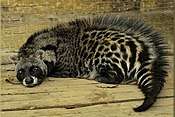 | |
| Hemigalinae | |||
| Hemigalus Jourdan, 1837 | Banded palm civet (H. derbyanus) Jourdan, 1837 | 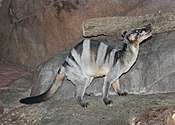 | |
| Cynogale Gray, 1837 | Otter civet (C. bennettii) Gray, 1837 |  | |
| Diplogale Thomas, 1912 | Hose's palm civet (D. hosei) (Thomas, 1892) | 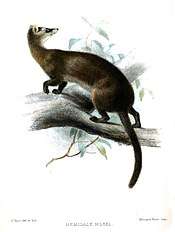 | |
| Chrotogale Thomas, 1912 | Owston's palm civet (C. owstoni) Thomas, 1912 | 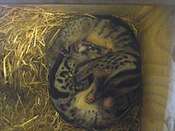 | |
| Paradoxurinae | Paradoxurus Cuvier, 1822 |
|
|
| Arctictis Temminck, 1824 | Binturong (A. binturong) (Raffles, 1822) | 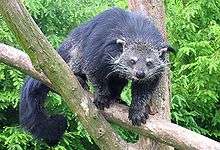 | |
| Paguma Gray, 1831 | Masked palm civet (P. larvata) Gray, 1831 | .jpg) | |
| Macrogalidia Schwarz, 1910 | Sulawesi palm civet (M. musschenbroekii) (Schlegel, 1877) | 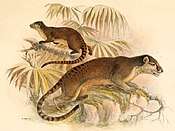 | |
| Arctogalidia Merriam, 1897 | Small-toothed palm civet (A. trivirgata) (Gray, 1832) | _(8076736823)_(cut).jpg) | |
| Genettinae | Genetta Cuvier, 1816 |
|
|
| Poiana Gray, 1864 |
|
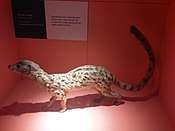 |
Phylogeny
The phylogenetic relationships of Viverridae are shown in the following cladogram:[2][10]
| Viverridae |
| |||||||||||||||||||||||||||||||||||||||||||||||||||||||||||||||||||||||||||||||||||||||||||||||||||||||||||||||||||||||||||||||||||||||||||||||||||||||||||||||||||||||||||||||||||||||||||||||||||||||||||||||||||||
Extinct species
| Subfamily | Genus | Species |
|---|---|---|
| Incertae sedis | Leptoplesictis Major, 1903[12] |
|
| Tugenictis Morales & Pickford, 2005[13][14] | T. ngororaensis[13] | |
| Kanuites Dehghani & Werdelin, 2008[15] | K. lewisae[15] | |
| Viverrinae | Viverra Linnaeus, 1758 | Leakey's civet (V. leakeyi) Leakey, 1982 |
| Semigenetta Helbing 1927 |
| |
| Paradoxurinae | Kichechia Savage, 1965[16] |
Ecology and behavior
They are generally solitary and have excellent hearing and vision. They are omnivorous; the palm civet is almost entirely herbivorous.[5]
Favored habitats include woodland, savanna, mountains, and above all tropical rainforest. Due to heavy deforestation, many face severe habitat loss. Several species, such as the Hose's palm civet, which is endemic to northern Borneo, are considered vulnerable. The otter civet is classified as endangered.[1]
References
- Wozencraft, W.C. (2005). "Family Viverridae". In Wilson, D.E.; Reeder, D.M (eds.). Mammal Species of the World: A Taxonomic and Geographic Reference (3rd ed.). Johns Hopkins University Press. pp. 548–559. ISBN 978-0-8018-8221-0. OCLC 62265494.
- Gaubert, P. & Cordeiro-Estrela, P. (2006). "Phylogenetic systematics and tempo of evolution of the Viverrinae (Mammalia, Carnivora, Viverridae) within feliformians: implications for faunal exchanges between Asia and Africa" (PDF). Molecular Phylogenetics and Evolution. 41 (2): 266–278. doi:10.1016/j.ympev.2006.05.034. PMID 16837215.

- Gray, J. E. (1821). "On the natural arrangement of vertebrose animals". London Medical Repository. 15 (1): 296–310.
- Pocock, R. I. (1939). "Family Viverridae". The Fauna of British India, including Ceylon and Burma. Mammalia. – Volume 1. London: Taylor and Francis. pp. 330–332.
- Wozencraft, W. C. (1984). Macdonald, D. (ed.). The Encyclopedia of Mammals. New York: Facts on File. pp. 134–135. ISBN 0-87196-871-1.
- Ewer, R. F. (1998). The Carnivores. Cornell University Press. ISBN 0-8014-8493-6.
- Bennett, E. T. (1833). "Notice of a new genus of Viverridous Mammalia from Madagascar". Proceedings of the Zoological Society of London. 1833: 46.
- Veron, G.; Catzeflis, F. M. (1993). "Phylogenetic relationships of the endemic Malagasy carnivore Cryptoprocta ferox (Aeluroideae): DNA/DNA hybridization experiments". Journal of Mammalian Evolution. 1 (3): 169–185. doi:10.1007/bf01024706.
- Gaubert, P.; Veron, G. (2003). "Exhaustive sample set among Viverridae reveals the sister-group of felids: the linsangs as a case of extreme morphological convergence within Feliformia". Proceedings of the Royal Society B: Biological Sciences. 270 (1532): 2523–2530. doi:10.1098/rspb.2003.2521. PMC 1691530. PMID 14667345.
- Nyakatura, K. & Bininda-Emonds, O. R. P. (2012). "Updating the evolutionary history of Carnivora (Mammalia): a new species-level supertree complete with divergence time estimates". BMC Biology. 10: 12. doi:10.1186/1741-7007-10-12. PMC 3307490. PMID 22369503.
- Groves, C. P.; Rajapaksha, C.; Manemandra-Arachchi, K. (2009). "The taxonomy of the endemic golden palm civet of Sri Lanka" (PDF). Zoological Journal of the Linnean Society. 155: 238–251. doi:10.1111/j.1096-3642.2008.00451.x.
- Morales, J., Pickford, M. and Salesa, M.J. (2008). "Creodonta and Carnivora from the Early Miocene of the Northern Sperrgebiet, Namibia". Memoir of the Geological Survey of Namibia. 20: 291–310.CS1 maint: uses authors parameter (link)
- Morales, J. & Pickford, M. (2005). "Carnivores from the Middle Miocene Ngorora Formation (13-12 Ma), Kenya" (PDF). Estudios Geológicos. 61: 271–284. doi:10.3989/egeol.05613-668.
- Werdelin, L. (2019). "Middle Miocene Carnivora and Hyaenodonta from Fort Ternan, western Kenya" (PDF). Geodiversitas. 41 (6).
- Dehghani, R. & Werdelin, L. (2008). "A new small carnivoran from the Middle Miocene of Fort Ternan, Kenya". Neues Jahrbuch für Geologie und Paläontologie-Abhandlungen. 248 (2): 233–244. doi:10.1127/0077-7749/2008/0248-0233.
- Savage, R. J. G. (1965). "Fossil mammals of Africa: 19, The Miocene Carnivora of East Africa". Bulletin of the British Museum (Natural History). 10 (8): 239–316.
- Adrian, B.; Werdelin, L. & Grossman, A. (2018). "New Miocene Carnivora (Mammalia) from Moruorot and Kalodirr, Kenya" (PDF). Palaeontologia Electronica. 21 (1 10A): 1–19. doi:10.26879/778.
External links
| Wikimedia Commons has media related to Viverridae. |
| Wikispecies has information related to Viverridae |
- "Genet: Wildlife summary". African Wildlife Foundation.
- University of Michigan's Animal Diversity Web page
- ITIS page
- The Straight Dope on Civet Cats